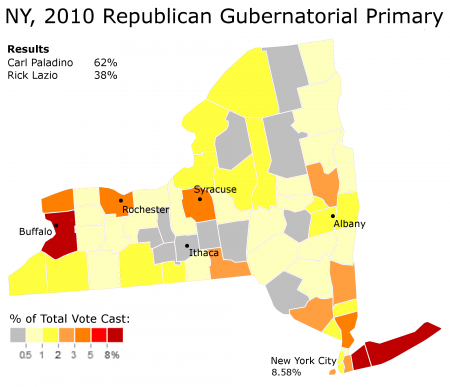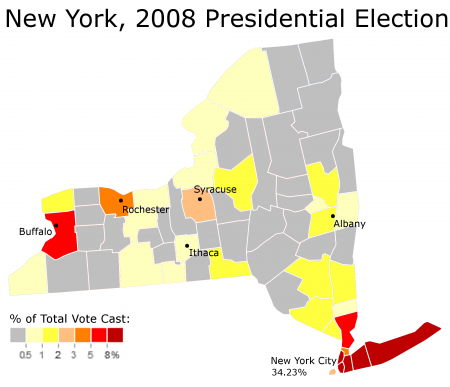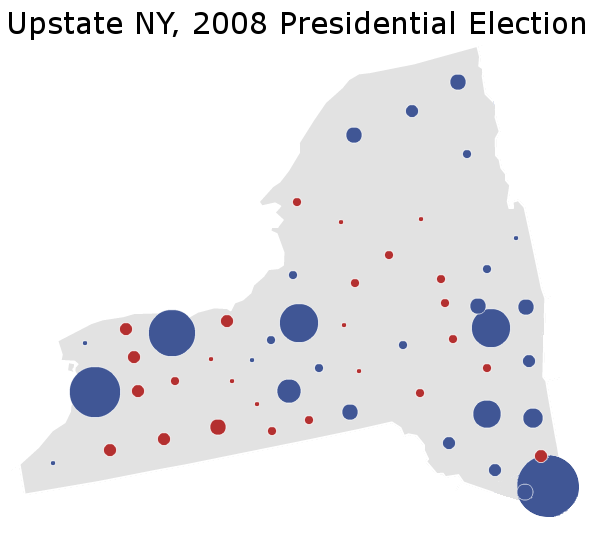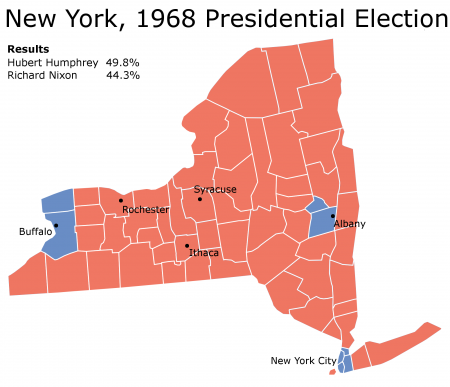This is the second part of two posts analyzing New York’s recent Republican primary. It will focus upon Republican weakness in New York City, as revealed by the primary. The previous part can be found here.
New York City in the Republican Primary
One of the more interesting things about American politics is the rural-urban divide. The weakness of the modern Republican Party in urban areas is quite astounding. Much of this has to do with the history of the American city, especially the way in which many cities have become reservoirs of poor minorities.
The Republican gubernatorial primary constituted a particularly powerful demonstration of Republican weakness in American cities. To illustrate this, let’s look at a map of turn-out in businessman Carl Paladino’s victory over former representative Rick Lazio:
More below.
This map shows the vote cast by each county as a percentage of the total vote cast in the primary. Erie County, for instance, cast 46,054 votes in the primary. Since 442,608 people voted in total, the county cast 10.41% of the total primary vote.
The turn-out map reveals some fascinating patterns. The biggest counties in the Republican primary were in Buffalo and Long Island. High number of Republicans also voted in Rochester, Syracuse, and Westchester County (north of New York City).
On the other hand, New York City participation in the Republican gubernatorial primary was dismal. Fewer people voted in the five boroughs combined than in Erie County (Buffalo). More than twice as many people voted in all Long Island than in New York City. In the Bronx, 2358 people decided to participate in the Republican primary. This is in a place where an estimated 1,382,793 people live.
Compare these figures to 2008 presidential election:
Here we see New York City punching at something closer to its actual strength. Like a giant magnet, New York City’s population pulls away influence from upstate New York and directs it to itself. Indeed, in the presidential election New York City is four times as important as it was in the 2010 gubernatorial Republican primary – constituting 34.23% of the total vote, compared to 8.58% in the Republican primary.
This really says something about the state of the Republican Party in New York City.
New York City in the General Election
The above two maps do not really hammer in the importance of New York City. Stating that five boroughs hold one-third of a state’s vote is one thing, but actually seeing it is another.
The previous post contained an image of New York in the 2008 presidential election. This map only reflected President Barack Obama’s performance in upstate New York, which he won by the high single digits. Here is a picture of said map:
(Note: Edited NYT Image. This map underestimates Mr. Obama’s strength, since it doesn’t include a number of absentee ballots and provisional ballots. Both, especially the absentees, tended to go more Democratic than the national average in 2008.)
This looks good for Mr. Obama. There is a lot of blue here and not a lot of red. In reality, however, most of the territory mapped above actually does not belong to the Democratic base. In a close election, almost all of these counties would go strongly Republican. These are the places that generally voted for Carl Paladino.
The real area of Democratic power is in New York City. Let’s add New York City to the above map:
Mr. Obama looks really good here; indeed, the blue margins are so large that it is hard to comprehend their magnitude.
Concluding Thoughts
All in all, the divide between New York City’s importance in the Republican primaries and its importance in the general election is quite amazing. It really points to what the Republican coalition of voters is like today. Cities are almost an afterthought; most Republicans assume they will vote Democratic anyways, and so they don’t even bother to compete.
In some states this can be a wise concession. In most states taking the suburbs and the rural areas – occasionally, winning just the rural areas – is enough to win a state election. Cities are not always necessary to win. On the other hand, they certainly are useful to win elections, especially in a state like New York.
Republican candidate Carl Paladino does not look like he will win the general election. Originally trailing Democratic Attorney General Andrew Cuomo 2-to-1, the Republican national wave has closed this to a high single-digit gap. This, however, will be hard to surmount – for much of the remaining gap lies in winning New York City voters, almost none of whom participated in the primary electorate which chose Mr. Paladino.







